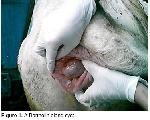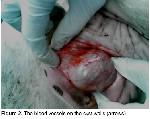In a study of slaughterhouse material from 200 cows,
Fathalla et al.
5 described many urinogenital problems
including Garthner gland cysts, but not a Bartholin gland
cyst. Thus, the fact that our case is of rare occurrence
makes it interesting.
Some authors3,5,10 mentioned that trauma and
extension at the time of calving lead to local necrotic
vulvo-vaginitis. This condition leading to obstruction of
the duct opening, as causes of Bartholin gland cysts
seen in older cows. However, their ideas are not
applicable once to our case, which involved an animal
which was young age and had not previously given a
birth.
Roberts3 stated that when the cystic gland
becomes larger than 5 cm in diameter it usually shows
between the vulvar lips when the cow is lying down as a
round pink mucosa-covered object that is often mistaken
for the beginning of a prolapse of the vagina. The
findings in this present case are in accordance with this
author, as the animal was brought to us as having a
prolapsed vagina.
Some authors3,10 considered that occasionally
when the cyst is large it protrudes through the vulvar lips
and becomes covered with feces and dirt. Then when the
cow gets up and the cyst returns to the pelvic canal,
contamination of the vestibule, vulva and caudal part of
the vagina may occur. The presence of the cystic
Bartholin gland was unilateral in all cases, the shape of
the external genitalia was distorted, and a degree of
vaginitis associated with this defect was noted in all
cows. However, while it was true in our case that the lips
of the vulva were open, there was no pelvic canal
contamination or related inflammation in the way that this
author describes.
Some researchers10,11 stated that the agent of
Brucella melitensis was isolated when they further
carried out microbiological culture of the contents of
cysts in both women and cows, and that they detected
albumin in biochemical analysis. In our case, no
microorganism was isolated upon the culture of the fluid
content of the cyst, although biochemical analysis of the
fluid revealed the presence of a high albumin content.
Cauvin et al.12 noted that vaginal cysts in dogs
might be caused by tenesmus and that the problem
could only be solved by draining the cyst. In our case,
however no defecation problems were observed
according to anamnesis and clinical findings. The cyst
caused no problems at parturition nor did it interfere with
conception as stated by Roberts3 and Fathalla10. In
the present case, the cyst was drained and there was no
relapse.
Wang et al.9 reported that 22 Bartholin gland cysts
or abcesses in women responded well to drainage by
puncturation. The same technique was used in this case
and the response was positive. Thus, drainage of such
cysts by puncturation can be an effective treatment.
Although many causes of Bartholin gland cysts are
known, no definitive cause could be ascribed in the
present case. This is because, as mentioned above, a
major cause of such cysts is believed to be old age or
trauma to the vagina3,10, which were not factors in the
present case of the animal under study.
There are many different causes, and treatments for
Bartholin gland cysts. However, the cysts do not have
an adverse effect on fertility or parturition; they are more
frequently seen in old cows and in those previously
calved yet, but as this case shows, they may also be
seen on animals which have not given birth.




